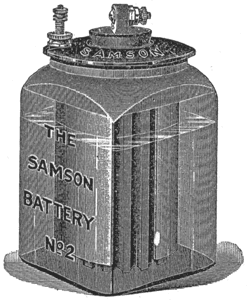[Trade Journal]
Publication: Western Electrician
Chicago, IL, United States
vol. 22, no. 9, p. 133-134, col. 3,1
Samson Battery.
Telephone transmitters require a battery with a low internal resistance on account of the low resistance of local circuit. Telephone users, therefore, are interested in obtaining a battery with the following characteristics: First, low internal resistance; second, high and uniform electromotive force; third, economical maintenance. That the Samson battery possesses all of these is demonstrated by these statements of the manufacturers:
 |
| Samson Battery. |
First — The internal resistance is .13 of an ohm,
Second — The electromotive force is 1.40 to 1.47 volts, and this voltage diminishes very slowly on hard and continuous work. A feature is its ability to regain its full power after short-circuit of considerable duration.
Third — The economy of the Samson battery will become manifest to everyone who will consider its long life and capacity for extraordinary work. While the first cost is certainly greater than that of many battery cells now in the market, it will out last four or five such cells, it is claimed, in addition to performing the work perfectly.
The Samson carbon is manufactured in France and is composed of two parts, a fluted lower portion and a threaded top carrying the binding-post, which are baked in one piece in the kiln. This feature is unlike any other carbon and is a necessary one to obtain the best results. The lower portion is a thin-walled, fluted, hollow cylinder, made from special materials and by a special process, resulting in a quality of battery carbon which, it is said, cannot be obtained in this country. While the crude carbon is remarkably pure, great care is taken to free it from all injurious elements, such as iron and other foreign substances, which would be liable to produce local action. The carbon mixture is subjected to a special patented process, which renders this portion, after baking, exceptionally porous. The top portion is composed of an entirely different kind of carbon from that used in the lower portion, and, after being subjected to enormous pressure, is treated when the carbon is complete in a way which renders it impervious to the creeping tendency of the solution and action of the ammonia gas.
The upper and lower portions, after being formed, are properly baked in the kiln, after which the top of the carbon is heated redhot and plunged in hot paraffine, so that it enters into the minutest pore instead of simply collecting on the outside, as is the case with many battery carbons. The carbon made in this way has a hard, dense top and a very porous lower portion. The manufacturers state that no other carbon is made in this manner, and that it is impossible to obtain the greatest advantages when a carbon is molded in one piece.
A combination of manganese and pea carbon is placed inside the fluted portion and held in position by a specially prepared plug which will not fall out. It is this depolarizer and its close proximity to the exceptionally porous carbon which imparts to the battery its remarkable recuperative qualities. It can be easily renewed. After the depolarizer has been placed inside the carbon the connection, made of brass heavily tinned, is affixed. It is composed of large, heavy parts and includes a safety check nut.
The result of this thorough and necessarily expensive mode of manufacture is the production of a battery carbon which is claimed to have a larger surface, longer life and greater recuperative power than any other carbon element ever manufactured.
Prof. H. S. Carhart in "Primary Batteries" says: "The amount of energy held potentially in the cell is represented by the weight of the zinc." Also that the use of the small zinc rod indicates large internal resistance. The Samson zinc is of the circular form and is well amalgamated. An important improvement in the battery has been made and the elements are now joined to the top in such a manner that it is impossible to short-circuit the carbon and zinc. The carbon is held half an inch away from the bottom, and the zinc is a trifle shorter than the carbon, to avoid possible bridging of salts. The battery is "shipped set up'' and having the package of sal ammoniac inside the jar. It is the first cell ever constructed embodying this desirable feature. The Samson is extensively used and carried in stock by leading supply dealers.
The Electric Gas Lighting company, Boston, Mass., is the agent in this country for the French manufacturers and will furnish pamphlets, prices and data upon application.
